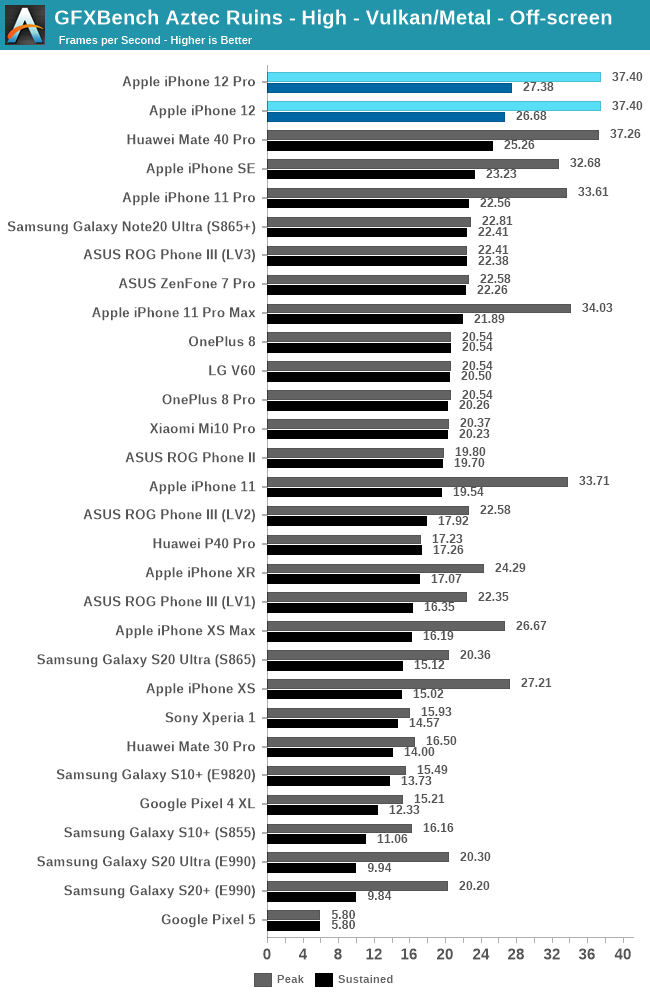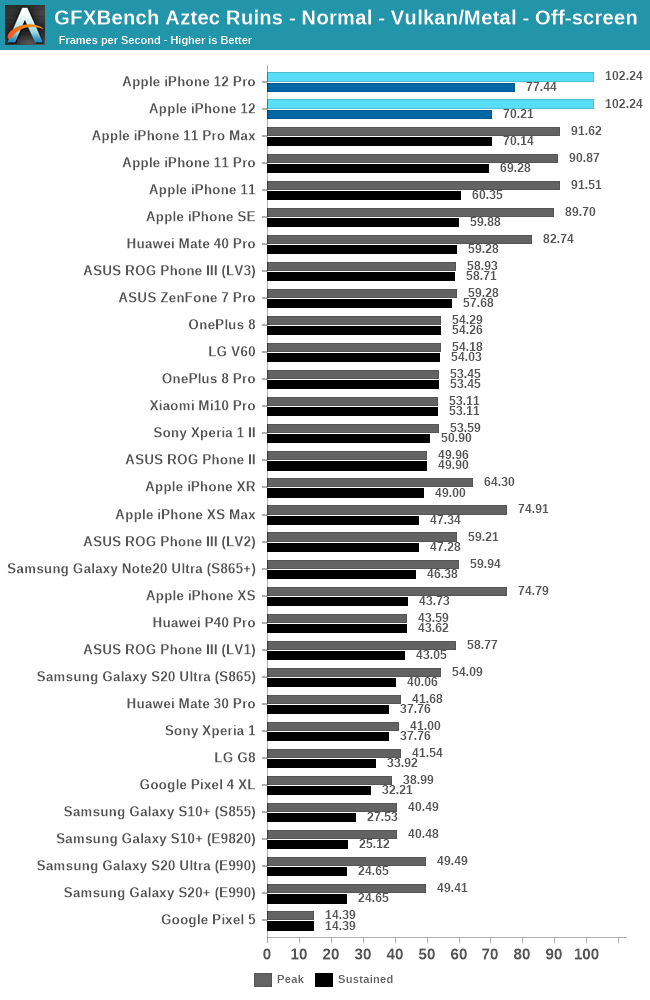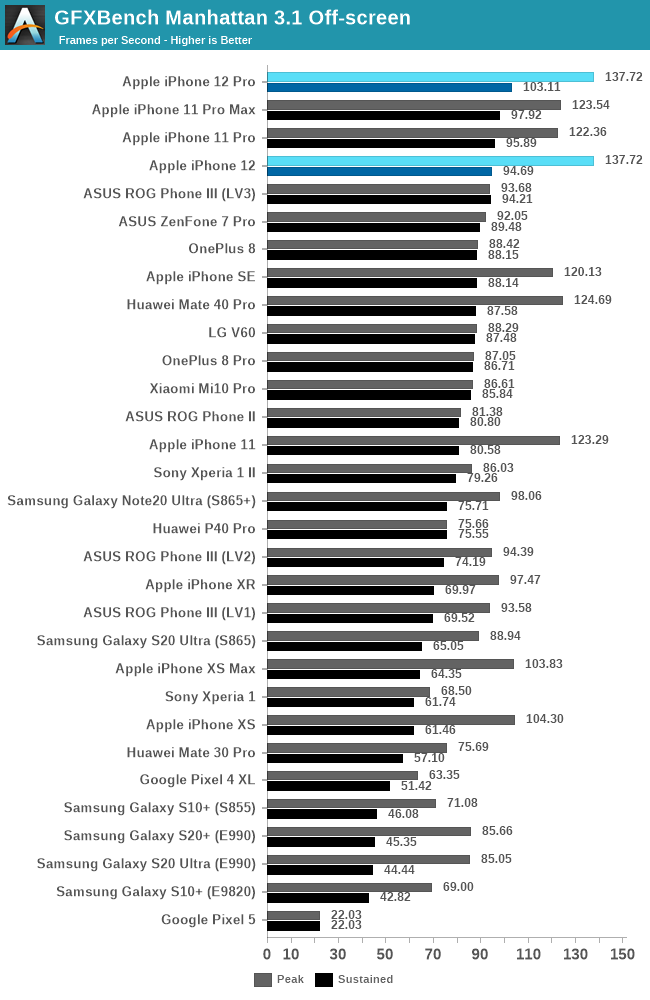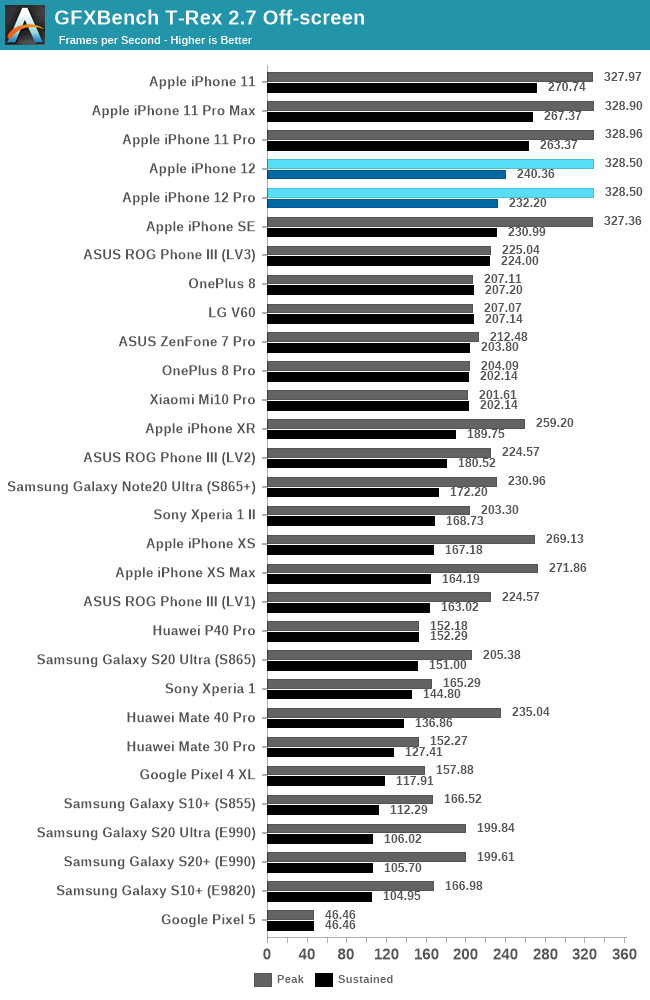The iPhone 12 & 12 Pro Review: New Design and Diminishing Returns
by Andrei Frumusanu on November 30, 2020 8:30 AM EST- Posted in
- Mobile
- Apple
- Smartphones
- Apple A14
- iPhone 12
- iPhone 12 Pro
GPU Performance & Power
GPU performance of the new A14 is something that wasn’t very clearly presented during the launch of the new iPhone 12 series. Apple had first introduced the A14 within the new iPad series where it had promised performance increases relative to the A12, not the previous generation A13, and with a bit of math this resulted into a translated 8.3% generational increase which is rather smaller than we had expected given Apple’s recent GPU trajectory over the years. Furthermore, this was also the first release where Apple compared itself to the Android SoC competition which is something the company doesn’t usually do. All these factored into some rather low expectations for the GPU of the A14 – so let’s see how that pans out in practice:

Starting off with Basemark GPU 1.2, we’re seeing a 17% increase in peak performance relative to the iPhone 11 Pro and the A13 chip, which is a nice upgrade, but doesn’t tell the whole story. In the sustained performance figure after 30 minutes of running and when the phone reaches a thermal equilibrium, we see a 45% drop in performance. In this instance, it looks like the iPhone 12 Pro reached a lower sustained performance level than the iPhone 11 Pro which isn’t a great start, but that might change with differing workloads.

In the Aztec High test, the iPhone 12’s fare a bit better in their sustained performances, with the new chip showing a 21% increase in performance generationally. The peak performance figure is only 11% higher but generally this isn’t the figure that is important for gaming experiences on iPhones.
| GFXBench Aztec High Offscreen Power Efficiency (System Active Power) |
||||
| Mfc. Process | FPS | Avg. Power (W) |
Perf/W Efficiency |
|
| iPhone 12 Pro (A14) 🔥 Throttled | N5 | 28.36 | 3.91 | 7.24 fps/W |
| iPhone 11 Pro (A13) 🔥 Throttled | N7P | 26.14 | 3.83 | 6.82 fps/W |
| iPhone 12 Pro (A14) ❄️ Peak | N5 | 37.40 | 5.57 | 6.64 fps/W |
| iPhone 11 Pro (A13) ❄️ Peak | N7P | 34.00 | 6.21 | 5.47 fps/W |
| Galaxy S20 Ultra (Snapdragon 865) | N7P | 20.35 | 3.91 | 5.19 fps/W |
| Mate 40 Pro (Kirin 9000) 🔥 Throttled | N5 | 27.37 | 5.39 | 5.07 fps/W |
| iPhone XS (A12) 🔥 Throttled | N7 | 19.32 | 3.81 | 5.07 fps/W |
| Reno3 5G (Dimensity 1000L) | N7 | 11.93 | 2.39 | 4.99 fps/W |
| iPhone XS (A12) ❄️ Peak | N7 | 26.59 | 5.56 | 4.78 fps/W |
| Mate 40 Pro (Kirin 9000) ❄️ Peak | N5 | 37.22 | 8.53 | 4.36 fps/W |
| ROG Phone III (Snapdragon 865+) | N7P | 22.34 | 5.35 | 4.17 fps/W |
| Mate 30 Pro (Kirin 990 4G) | N7 | 16.50 | 3.96 | 4.16 fps/W |
| Galaxy S20+ (Exynos 990) | 7LPP | 20.20 | 5.02 | 3.59 fps/W |
| Galaxy S10+ (Snapdragon 855) | N7 | 16.17 | 4.69 | 3.44 fps/W |
| Galaxy S10+ (Exynos 9820) | 8LPP | 15.59 | 4.80 | 3.24 fps/W |
Looking at the power consumption of the new phones, we see again that both the peak and throttled performance figures of the new chip isn’t all that much different to the previous generation, as we’re seeing roughly 8% better performance at almost the same power envelope of around 3.9W. The peak power figure of the new chip seems to have been reduced this generation and that’s very much a welcome change, and that’s where the efficiency sees the largest delta to the A13.

In the normal setting configuration of the Aztec test, we’re seeing again a 11% increase in sustained performance generationally, and a similar 12% boost in peak performance. These are good improvements but still a bit less than we had expected given the A14’s new process node and new GPU.
| GFXBench Aztec Normal Offscreen Power Efficiency (System Active Power) |
||||
| Mfc. Process | FPS | Avg. Power (W) |
Perf/W Efficiency |
|
| iPhone 12 Pro (A14) 🔥 Throttled | N5 | 77.44 | 3.88 | 19.95 fps/W |
| iPhone 12 Pro (A14) ❄️ Peak | N5 | 102.24 | 5.53 | 18.48 fps/W |
| iPhone 11 Pro (A13) 🔥 Throttled | N7P | 73.27 | 4.07 | 18.00 fps/W |
| iPhone 11 Pro (A13) ❄️ Peak | N7P | 91.62 | 6.08 | 15.06 fps/W |
| iPhone XS (A12) 🔥 Throttled | N7 | 55.70 | 3.88 | 14.35 fps/W |
| Galaxy S20 Ultra (Snapdragon 865) | N7P | 54.09 | 3.91 | 13.75 fps/W |
| iPhone XS (A12) ❄️Peak | N7 | 76.00 | 5.59 | 13.59 fps/W |
| Reno3 5G (Dimensity 1000L) | N7 | 27.84 | 2.12 | 13.13 fps/W |
| Mate 40 Pro (Kirin 9000) 🔥 Throttled | N5 | 63.56 | 5.37 | 11.84 fps/W |
| ROG Phone III (Snapdragon 865+) | N7P | 58.77 | 5.34 | 11.00 fps/W |
| Mate 40 Pro (Kirin 9000) ❄️ Peak | N5 | 82.74 | 7.95 | 10.40 fps/W |
| Mate 30 Pro (Kirin 990 4G) | N7 | 41.68 | 4.01 | 10.39 fps/W |
| Galaxy S20+ (Exynos 990) | 7LPP | 49.41 | 4.87 | 10.14 fps/W |
| Galaxy S10+ (Snapdragon 855) | N7 | 40.63 | 4.14 | 9.81 fps/W |
| Galaxy S10+ (Exynos 9820) | 8LPP | 40.18 | 4.62 | 8.69 fps/W |
The power figures showcase a similar generational movement, with a slight performance increase at a slight power decrease. It’s good progression but again not quite fulfilling our expectations of a new process node bump.

| GFXBench Manhattan 3.1 Offscreen Power Efficiency (System Active Power) |
||||
| Mfc. Process | FPS | Avg. Power (W) |
Perf/W Efficiency |
|
| iPhone 12 Pro (A14) 🔥 Throttled | N5 | 103.11 | 3.90 | 26.43 fps/W |
| iPhone 12 Pro (A14) ❄️ Peak | N5 | 137.72 | 5.63 | 24.46 fps/W |
| iPhone 11 Pro (A13) 🔥 Throttled | N7P | 100.58 | 4.21 | 23.89 fps/W |
| Galaxy S20 Ultra (Snapdragon 865) | N7P | 88.93 | 4.20 | 21.15 fps/W |
| iPhone 11 Pro (A13) ❄️Peak | N7P | 123.54 | 6.04 | 20.45 fps/W |
| iPhone XS (A12) 🔥 Throttled | N7 | 76.51 | 3.79 | 20.18 fps/W |
| Reno3 5G (Dimensity 1000L) | N7 | 55.48 | 2.98 | 18.61 fps/W |
| Mate 40 Pro (Kirin 9000) 🔥 Throttled | N5 | 87.31 | 4.98 | 17.54 fps/W |
| iPhone XS (A12) ❄️Peak | N7 | 103.83 | 5.98 | 17.36 fps/W |
| ROG Phone III (Snapdragon 865+) | N7P | 93.58 | 5.56 | 16.82 fps/W |
| Mate 40 Pro (Kirin 9000) ❄️Peak | N5 | 124.69 | 8.28 | 15.05 fps/W |
| Mate 30 Pro (Kirin 990 4G) | N7 | 75.69 | 5.04 | 15.01 fps/W |
| Galaxy S20+ (Exynos 990) | 7LPP | 85.66 | 5.90 | 14.51 fps/W |
| Galaxy S10+ (Snapdragon 855) | N7 | 70.67 | 4.88 | 14.46 fps/W |
| Galaxy S10+ (Exynos 9820) | 8LPP | 68.87 | 5.10 | 13.48 fps/W |
| Galaxy S9+ (Snapdragon 845) | 10LPP | 61.16 | 5.01 | 11.99 fps/W |
| Mate 20 Pro (Kirin 980) | N7 | 54.54 | 4.57 | 11.93 fps/W |
| Galaxy S9 (Exynos 9810) | 10LPP | 46.04 | 4.08 | 11.28 fps/W |
| Galaxy S8 (Snapdragon 835) | 10LPE | 38.90 | 3.79 | 10.26 fps/W |
| Galaxy S8 (Exynos 8895) | 10LPE | 42.49 | 7.35 | 5.78 fps/W |
Depending on the workload, the generational performance increases can be even smaller, as here in Manhattan the performance increase in a throttled state is only 3% better for the new A14 based iPhone, with also a minor power decrease at this state.

| GFXBench T-Rex Offscreen Power Efficiency (System Active Power) |
||||
| Mfc. Process | FPS | Avg. Power (W) |
Perf/W Efficiency |
|
| iPhone 12 Pro (A14) 🔥 Throttled | N5 | 260.28 | 4.08 | 63.97 fps/W |
| iPhone 11 Pro (A13) 🔥 Throttled | N7P | 289.03 | 4.78 | 60.46 fps/W |
| iPhone 12 Pro (A14) ❄️ Peak | N5 | 328.50 | 5.55 | 59.18 fps/W |
| iPhone 11 Pro (A13) ❄️ Peak | N7P | 328.90 | 5.93 | 55.46 fps/W |
| Galaxy S20 Ultra (Snapdragon 865) | N7P | 205.37 | 3.83 | 53.30 fps/W |
| Mate 40 Pro (Kirin 9000) 🔥 Throttled | N5 | 147.13 | 2.92 | 50.38 fps/W |
| iPhone XS (A12) 🔥 Throttled | N7 | 197.80 | 3.95 | 50.07 fps/W |
| ROG Phone III (Snapdragon 865+) | N7P | 224.48 | 4.92 | 45.60 fps/W |
| iPhone XS (A12) ❄️Peak | N7 | 271.86 | 6.10 | 44.56 fps/W |
| Galaxy 10+ (Snapdragon 855) | N7 | 167.16 | 4.10 | 40.70 fps/W |
| Reno3 5G (Dimensity 1000L) | N7 | 139.30 | 3.57 | 39.01 fps/W |
| Mate 40 Pro (Kirin 9000) ❄️ Peak | N5 | 235.04 | 6.11 | 38.46 fps/W |
| Galaxy S20+ (Exynos 990) | 7LPP | 199.61 | 5.63 | 35.45 fps/W |
| Mate 30 Pro (Kirin 990 4G) | N7 | 152.27 | 4.34 | 35.08 fps/W |
| Galaxy S9+ (Snapdragon 845) | 10LPP | 150.40 | 4.42 | 34.00 fps/W |
| Galaxy 10+ (Exynos 9820) | 8LPP | 166.00 | 4.96 | 33.40fps/W |
| Galaxy S9 (Exynos 9810) | 10LPP | 141.91 | 4.34 | 32.67 fps/W |
| Galaxy S8 (Snapdragon 835) | 10LPE | 108.20 | 3.45 | 31.31 fps/W |
| Mate 20 Pro (Kirin 980) | N7 | 135.75 | 4.64 | 29.25 fps/W |
| Galaxy S8 (Exynos 8895) | 10LPE | 121.00 | 5.86 | 20.65 fps/W |
Finally, T-Rex showcases no improvements on the part of peak performance figures, although it does lower power consumption, and sustained performance for some reason is lower on the newer generation iPhone, although again it showcases quite lower power consumption so it’s possible the new chip is mainly running on the efficiency CPU cores in this workload.
Reasonable Upgrades
Generally speaking, our concerns over Apple’s lacklustre marketing on the GPU side of things seem to have been warranted as the new A14 and the 5nm process node doesn’t seem to bring substantial gains this generation. Performance is a little higher, and efficiency has also gone up as well, but it’s nowhere near the levels of improvements that Apple had been able to achieve with the A12 and A13. On one side that’s pretty understandable as those two generations had made huge leaps, and on the other hand it was maybe unreasonable to expect Apple to continue to make such gigantic strides on every generation.
Overall, the new iPhone 12 devices and the A14 still offer the very best gaming performance of any smartphone out in the market, showcasing significantly better experiences than any other Android competitor, but it’s also not a major noticeable upgrade over the iPhone 11 series devices.










101 Comments
View All Comments
anshelanancy - Wednesday, December 2, 2020 - link
This iPhone 12 is really well designed but high cost and released in some countries normally we can buy it online. I want to buy this but it isn't released in my country. I must buy this phone but this time I am so much busy with my office work https://accountancyseekers.co.uk/ here doing work as a marketing executive since 2017.Byte - Tuesday, December 15, 2020 - link
I kept my X to play games on and found it hurts to hold the X now because the the whole side feels sharp now. Am i weird?Laga Goteborg - Thursday, June 24, 2021 - link
iPhone 12 LCD screens are much tougher than before, we had cases that glass was intact but LCD under glass was shattered. However we could always fix the problem via https://www.LagaiPhone.se/KPOM - Monday, November 30, 2020 - link
The 12 mini hits the sweet spot for design and features this year, and I’m surprised it isn’t selling better (apparently Apple is seeing more demand than expected for the Pro and Max and somewhat less for the 12 and mini).I agree that the 12 Pro is a bit heavy and the new design isn’t as easy to hold as the 11 Pro. But the mini is only slightly bigger than the original iPhone SE/5/5s, and is the most comfortable phone to hold that I’ve seen in years.
Bob Todd - Monday, November 30, 2020 - link
I assume some of it is just that people have gotten accustomed to gargantuan phones over time and it can be a bit of a shock to scale back down. After holding the 12 mini in one hand and my OnePlus 6 in the other, I was certainly hesitant to give up that much screen. It was mostly fond memories of my Essential Phone's form factor that pushed me to choose the mini. My wife on the other hand is eyeing the regular 12 for this exact reason. She's accustomed to the size of her OnePlus 7T and the progressively larger phones that have landed her there.lmcd - Tuesday, December 1, 2020 - link
I personally think that it's due to upgrade cycle timing -- why buy a 12 mini if you just bought an SE 2020?I think a lot of people in that niche picked up an SE and also are already the type to hold onto their phones longer.
techconc - Monday, December 7, 2020 - link
Agreed. I have the 12 Pro, but after feeling the 12 mini in my hand (and in my pocket), I think I may go mini next time.ikjadoon - Monday, November 30, 2020 - link
The Mini is limited to 12W peak MagSafe, unlike “up to 15W” on all the other models.https://support.apple.com/en-us/HT211829
Jetcat3 - Monday, November 30, 2020 - link
12W peak with a 2227 mAh cell is non issue in my opinion.Andrei, in your testing did you notice increased black levels with low APL’s at brightness levels between 0-40%?
ikjadoon - Monday, November 30, 2020 - link
I don't think a single person genuinely cares or notices peak charging rates: minutes at best? Though the first page chart is a little incorrect.On displays, I'd be much more interested in power consumption of the two panels, so we can compare with the 11 Pro.